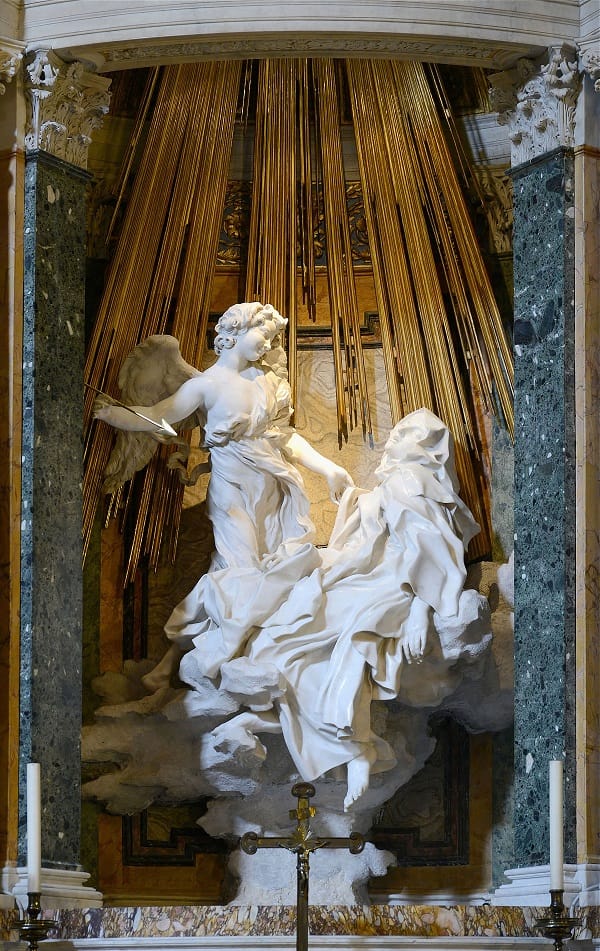The Ecstasy of St Teresa
Richard England eulogises on one of his favourite 17th century art works, The Ecstasy of St Teresa by Gian Lorenzo Bernini at Santa Maria Della Vittoria, Rome
Gian Lorenzo Bernini was not only one of the most prominent artists of his time, but also a multi-disciplinarian practitioner of all the other visual arts. Apart from his superb sacred and secular buildings, his body of works of sculpture in marble remain among the most impressive of all time and many consider them incomparable. So great was his reputation during his lifetime that he was often referred to as the Michelangelo of his century. Even at an early age, Bernini was already working for powerful and wealthy patrons and was soon even receiving Papal commissions. His sculptural work in marble pioneered a new approach to architecture, with his dynamic exact realism and theatrical composition. His David, and Apollo and Daphne, are perfect manifestations of his genius engulfing the marble with not only a life-like intensity, tension and torsion, but also with overall ethereal rapturous quality. In contrast to his rival Borromini’s brooding character, Bernini appears to have been a cordial, congenial personality conducive to maintaining affable relationships with his many clients and patrons.

The Ecstasy of St Teresa by Gian Lorenzo Bernini at Santa Maria Della Vittoria, Rome, photo credit wikimedia
My favourite work of this unique artist is his Ecstasy of St Teresa in the Cornaro Chapel in the church dedicated to Santa Maria della Vittoria in Rome, representing the spiritual rapture of the mystical Spanish Carmelite Nun (1515-1582) at her encounter with an angel. This extravagant Baroque piece may be considered a total choreographic work where painting, sculpture and architecture are one inseparable whole. Rudolf Wittkower uses the term ‘Gesamtkunstwerk’ totality of the arts. Bernini’s treatment of the whole ambiance makes the Chapel more of a theatre than a sacred venue. Here the master alloys in an exuberant, theatrical narrative, a euphoric combination of art, sculpture and theatre. The sculpture itself is ignited and ablaze with incandescent light beams descending from the high-level lunette. Bernini’s handling of the Saint’s drapery is magical in its delicacy and frailty, with its depictions of folds and creases of her loose garments, as if to make one think that the figure is actually clothed in real vestments. So superbly and meticulously carved is the marble that Teresa appears in her dematerialisation as if she is clothed more in silk than in marble. What is even more astounding is the way Bernini renders the saint’s ecstasy. The artist recounts that he was inspired by the Saint’s own spiritual account of her visions and modelled the sculpture on her narrative. In an almost erotic language, she describes the angel as “marvellously beautiful with a face which shone as though he was a seraphim,” and then continues that “I saw in his hands a long golden spear… this he thrust several times into my heart and it penetrated to my entrails. When he drew out the spear it left me all on fire with a wondrous love for God”. The Saint refers to her experiencing a pain both excruciating yet also sweet.
In Bernini’s sculpture, the Saint is depicted in ecstasy swooning in spiritual bliss – or is it sexually charged, erotic exhilaration? While the angel is lithe, delicate and sylphlike, the sculptor’s depiction of the Saint’s facial expression of divine joy reads almost as if she were experiencing a physical orgasm during her spiritual awakening. Bernini however, was not only concerned with the design of the sculpture, but much more so on its setting. As such, he designed the chapel as a small theatre and as a choreographic show case to focus on the sculpture as the main focus. Theatrically illuminated by shafts of natural light filtering in from concealed top lights and further adorned by the artists golden heavenly rays, the sculpture appears as an emblazoned Divine apparition. The whole is an extravagant Baroque setting in a magnificent combination of all the visual arts.
Laterally, the chapel holds theatre boxes rendered in polychrome marbles with members of the Cornaro family participating in the whole theatrical setting. In Bernini’s sculpture, divinity intrudes on humanity; the heavenly meets the earthly and the spiritual encounters the materialistic. Bernini’s ambiance and dramatic setting, together with his virtuoso treating of the sculpture itself, makes this whole ensemble perhaps the apogee of this master’s work. I do not think that on my numerous trips to Rome I have ever missed visiting the Cornaro chapel to pay homage to what I consider to be one of the greatest artworks of all time.










